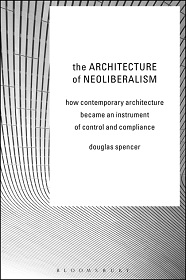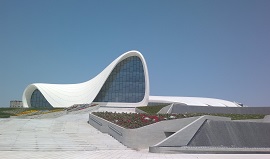Main author
Michael BrooksThe Architecture of Neoliberalism
Douglas Spencer - ‘The Architecture of Neoliberalism: How contemporary architecture became an instrument of control and compliance’
Published by Bloomsbury Academic (2016)
When Zaha Hadid died in 2016, she was celebrated as one of the 21st century’s most influential and visionary architects. Buildings such as the Guangzhou Opera House, the London Aquatics Centre, and the Heydar Aliyev Cultural Centre demonstrated a radical and futuristic aesthetic that was very much her own.
However, her critics also made mention of the human rights controversies which dogged her later career; in particular, the building of the Qatar World Cup Stadium, for which she claimed an abdication of responsibility.
More recently, Hadid’s successor, Patrick Schumacher, attracted considerable opprobrium when he advocated untrammelled gentrification and the privatisation of all social housing and public space, including Hyde Park.
According to Douglas Spencer, such pronouncements and controversies, far from being isolated events, are very much bound up in the architecture of neoliberalism that has developed over the last couple of decades, and which he critiques in his challenging and uncompromising book.
Neoliberalism is one of those buzzwords that is often used but seldom completely understood. In short it is a form of capitalism that promotes shrinking the state and public services in favour of privatisation, and any notion of the 'common good' is surrendered to the ‘logic of the market'. It was developed as an ideology by the likes of Hayek and Friedman, and introduced in the West by Thatcher and Reagan in the 1980s.
Spencer’s book is perhaps the first to analyse neoliberalism in conjunction with its architectural expressions. He joins the intellectual dots from 20th century countercultural thinkers such as Foucault and Lefevre, to some of the 21st century’s most celebrated architectural practices. In addition to Hadid and Schumacher, the book provides incisive analysis of the likes of Rem Koolhaas, Alejandro Zaera-Polo and Greg Lynn, and deconstructs buildings such as the CCTV Headquarters in Beijing, Birmingham New Street station, and the BMW factory in Leipzig.
Overall, this is a complex and tough read, which will likely only appeal to those steeped in architectural theory and criticism. But that does not make the book any less important or timely. Indeed at this disorientating time of change, when the foundations of the neoliberal ideology appear to be buckling beneath the weight demonstrable failures, it is a powerful and instructive piece of work.
To find out more and purchase the book click here.
[edit] Find out more
[edit] Related articles on Designing Buildings Wiki
- Charles Waldheim - Landscape as Urbanism: A General Theory.
- Interview with Tom Dyckhoff.
- Last Futures: Nature, Technology and the End of Architecture.
- Living in the hyperreal post-modern city.
- Neo-futurism.
- Public space intervention.
- Owen Hatherley - Landscapes of Communism.
- The architectural profession.
- Zaha Hadid.
Featured articles and news
Delivering for tenants; National Retrofit Hub
New report offers recommendations to strengthen energy efficiency standards to protect private renters.
Government consultations for the summer of 2025
A year of Labour, past and present consultations on the environment, the built environment, training and tax.
CMA competitiveness probe of major housing developers
100 million affordable housing contributions committed with further consultation published.
Homes England supports Greencore Homes
42 new build affordable sustainable homes in Oxfordshire.
Zero carbon social housing: unlocking brownfield potential
Seven ZEDpod strategies for brownfield housing success.
CIOB report; a blueprint for SDGs and the built environment
Pairing the Sustainable Development Goals with projects.
Types, tests, standards and fires relating to external cladding
Brief descriptions with an extensive list of fires for review.
Latest Build UK Building Safety Regime explainer published
Key elements in one short, now updated document.
UKGBC launch the UK Climate Resilience Roadmap
First guidance of its kind on direct climate impacts for the built environment and how it can adapt.
CLC Health, Safety and Wellbeing Strategy 2025
Launched by the Minister for Industry to look at fatalities on site, improving mental health and other issues.
One of the most impressive Victorian architects. Book review.
Common Assessment Standard now with building safety
New CAS update now includes mandatory building safety questions.
RTPI leader to become new CIOB Chief Executive Officer
Dr Victoria Hills MRTPI, FICE to take over after Caroline Gumble’s departure.
Social and affordable housing, a long term plan for delivery
The “Delivering a Decade of Renewal for Social and Affordable Housing” strategy sets out future path.
A change to adoptive architecture
Effects of global weather warming on architectural detailing, material choice and human interaction.
The proposed publicly owned and backed subsidiary of Homes England, to facilitate new homes.
How big is the problem and what can we do to mitigate the effects?
Overheating guidance and tools for building designers
A number of cool guides to help with the heat.
The UK's Modern Industrial Strategy: A 10 year plan
Previous consultation criticism, current key elements and general support with some persisting reservations.
Building Safety Regulator reforms
New roles, new staff and a new fast track service pave the way for a single construction regulator.




























